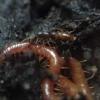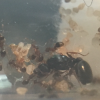Was looking inside a partially rotten landing that was being replaced, hoping to find what I believe to be a Camponotus vicinus colony, and instead found these girls.
Sorry for the blurry photos. Camera is charging and I'm hoping the outline looked unique enough. As said, found in decaying, half buried wood. I could be wrong, but they sure seem to look like some kind of Aphaenogaster, possibly A. rudis? I found a sole queen in one gallery, and possibly two queens (or a queen and a dealate?) in a second less than a foot away. The first colony may have had a 50-100 workers, the second 100-200. I'm pretty sure there's no polygyneous Aphaenogaster in the states though, right? That second queen confuses me. I really hope I didn't accidentally mix colonies, but if I did, the boundary between the two damn near nonexistent.
Queens are 6mm long on the dot, and with the workers being a bit under 4 and super bitey. They're all a dark, reddish brown with some workers having a darker brown gaster, and some having almost their entire body having that darker reddish brown coloration. I'm not sure if that's due to some of the workers being younger or what, but the difference in coloration between some is more pronounced than I'm used to. I can try to take better photos if necessary, but as always, my camera is rather hit and miss.
- Formiculture.com
- Forums
- Gallery
- Members
- Member Map
- Chat

















